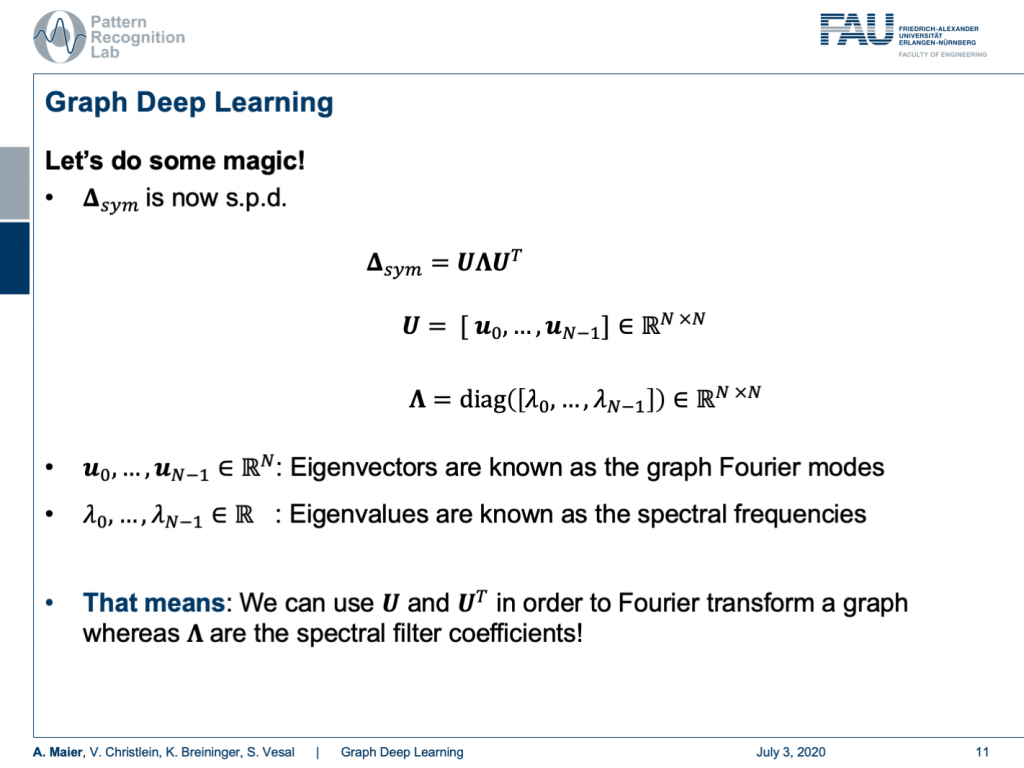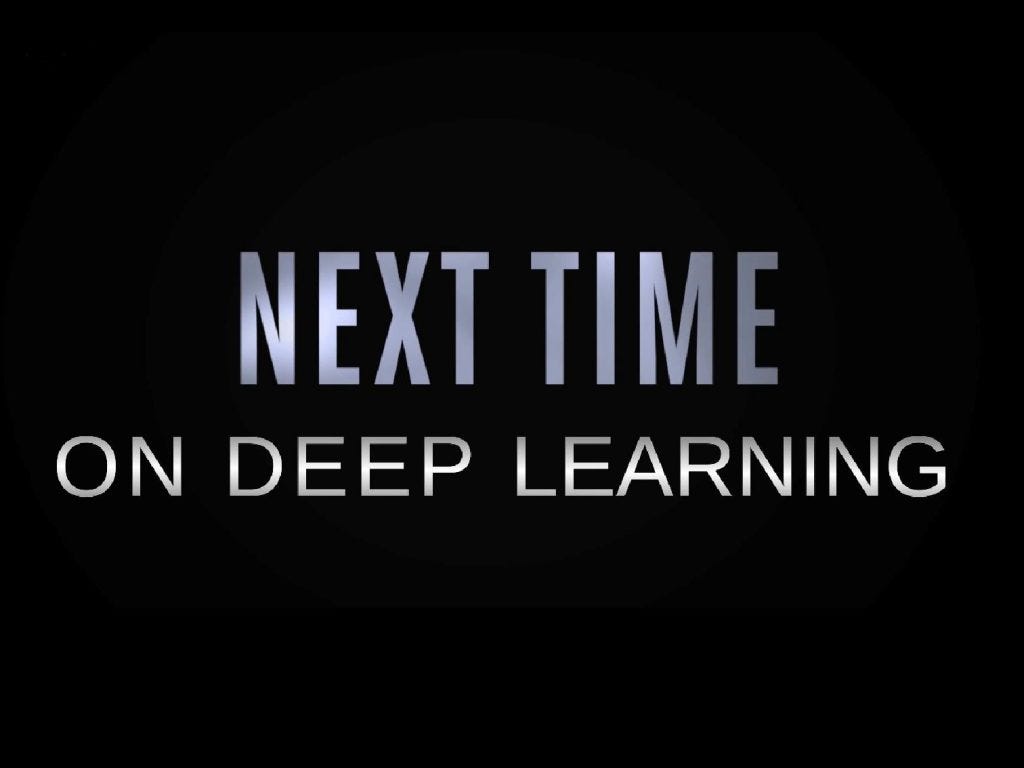有关深层学习的FAU讲义 (FAU LECTURE NOTES ON DEEP LEARNING)
These are the lecture notes for FAU’s YouTube Lecture “Deep Learning”. This is a full transcript of the lecture video & matching slides. We hope, you enjoy this as much as the videos. Of course, this transcript was created with deep learning techniques largely automatically and only minor manual modifications were performed. Try it yourself! If you spot mistakes, please let us know!
这些是FAU YouTube讲座“ 深度学习 ”的 讲义 。 这是演讲视频和匹配幻灯片的完整记录。 我们希望您喜欢这些视频。 当然,此成绩单是使用深度学习技术自动创建的,并且仅进行了较小的手动修改。 自己尝试! 如果发现错误,请告诉我们!
导航 (Navigation)
Previous Lecture / Watch this Video / Top Level / Next Lecture
上一个讲座 / 观看此视频 / 顶级 / 下一个讲座

Welcome back to deep learning! So today, we want to look a bit into how to process graphs and we will talk a bit about graph convolutions. So let’s see what I have here for you. Topic today will be an introduction to graph deep learning.
欢迎回到深度学习! 因此,今天,我们想研究一下如何处理图形,并讨论图形卷积。 因此,让我们看看我在这里为您提供的服务。 今天的主题将是图深度学习的介绍。

Well, what’s graph deep learning? You could say this is a graph, right? We know that from math that we can plot graphs. But this is not what we’re going to talk about today. Also, you could say a graph is like a plot like this one. But these are also not the plots that we want to talk about today. So is it Steffi Graf? No, we are also not talking about Steffi Graf. So what we actually want to look at are more things like this like diagrams that can be connected with different nodes and edges.
那么,什么是图深度学习? 您可以说这是一个图,对吗? 从数学知道,我们可以绘制图形。 但这不是我们今天要谈论的。 此外,您可以说图形就像这样的图形。 但是,这些也不是我们今天要谈论的情节。 那是Steffi Graf吗? 不,我们也没有在谈论Steffi Graf。 因此,我们实际上要看的是更多类似图的东西,它们可以与不同的节点和边连接。

A computer scientist thinks of a graph as a set of nodes and they are connected through edges. So this is the kind of graph that we want to talk about today. For a mathematician, a graph is a manifold, but a discrete one.
计算机科学家将图视为一组节点,并且它们通过边连接。 这就是我们今天要讨论的图表。 对于数学家来说,图是流形,但是离散的。

Now, how would you define a convolution? On euclidean space, well both for computer scientists and mathematicians this is too easy. So this is the discrete convolution which is essentially just a sum. We remember we had many of those discrete convolutions when we are setting up the kernels for our convolutional deep models. In the continuous form, it actually takes the following form: It’s essentially an integral that is computed over the entire space and I brought an example here. So if you want to convolve two Gaussian curves, then you essentially move them over each other multiply at each point and sum them up. Of course, the convolution of two Gaussians is a Gaussian again so this is also easy.
现在,您将如何定义卷积? 在欧几里德空间上,对于计算机科学家和数学家来说,这都太容易了。 因此,这就是离散卷积,本质上只是一个和。 我们记得在为卷积深度模型设置内核时,曾有很多离散卷积。 在连续形式中,它实际上采取以下形式:它本质上是一个在整个空间中计算的整数,在此我举了一个例子。 因此,如果要对两条高斯曲线进行卷积,则实际上是将它们在每个点上彼此相乘,然后求和。 当然,两个高斯的卷积又是高斯,因此这也很容易。

How would you define a convolution on graphs? Now, the computer scientist thinks really hard but … What the heck! Well, the mathematician knows that we can use Laplace transforms in order to describe convolutions and therefore we look into the laplacian that is here given as the divergence of the gradient. So in math, we can deal with these things more easily.
您如何定义图的卷积? 现在,计算机科学家真的很努力地思考,但是……这太糟糕了! 好吧,数学家知道我们可以使用拉普拉斯变换来描述卷积,因此我们研究了拉普拉斯算子,这里给出的是梯度散度。 因此,在数学上,我们可以更轻松地处理这些事情。

This then brings us to this manifold idea. We know how to convolve manifolds, we can discretize convolutions, and this means that we know how to convolve graphs.
然后,这使我们想到了这个多方面的想法。 我们知道如何对流形进行卷积,我们可以使卷积离散化,这意味着我们知道如何对图进行卷积。

So, let’s diffuse some heat! We know that we can describe Newton’s law of cooling as the following equation. We also know that the development over time can be described with the Laplacian. So, f(x,t) is then the amount of heat at point x at time t. Then, you need to have an initial heat distribution. So, you need to know how the heat is in the initial state. Then, you can use the Laplacian in order to express how the system behaves over time. Here, you can see that this is essentially the difference between f(x) and the average of f on an infinite decimal small sphere around x.
因此,让我们散发一些热量! 我们知道我们可以将牛顿冷却定律描述为以下等式。 我们也知道,随着时间的发展可以用拉普拉斯人来描述。 因此,f(x,t)就是时间t处x点的热量。 然后,您需要具有初始热分布。 因此,您需要知道热量在初始状态如何。 然后,您可以使用拉普拉斯算子来表达系统随着时间的变化。 在这里,您可以看到,这实际上是f(x)与x周围无穷小十进制小球体上f的平均值之间的差。

Now, how do we express the Laplacian in discrete form? Well, that’s the difference between f(x) and the average of f on an infinitesimal sphere around x. So, the smallest step that we can do is actually connect the current node with its neighbors. So, we can express the Laplacian as a weighted sum over the edge weights a subscript i and j. This is then the difference of our center node f subscript i minus f subscript j and we divide the whole thing by the number of connections that actually are incoming into f subscript i. This is going to be given as d subscript i.
现在,我们如何以离散形式表示拉普拉斯算子? 好吧,这就是f(x)与x周围无穷小球面上f的平均值之间的差。 因此,我们可以做的最小步骤是实际上将当前节点与其邻居连接起来。 因此,我们可以将拉普拉斯算子表示为边缘权重下标i和j的加权和。 这就是我们的中心节点f下标i减去f下标j的差,我们将整个事物除以实际进入f下标i的连接数。 这将以d下标i给出。

Now is there another way of expressing this? Well, yes. We can do this if we look at an example graph here. So, we have the nodes 1, 2, 3, 4, 5, and 6. We can now compute the Laplacian matrix using the matrix D. D is now simply the number of incoming connections into the respective nodes. So, we can see that Node 1 has two incoming connections, Node 2 has three, Node 3 has two, Node 4 has three, and Node 5 also has three, Node 6 has only one incoming connection. What we else need is the matrix A. That’s the adjacency matrix. So here, we have a 1 for every node that is connected with a different node and you can see it can be expressed with the above matrix now. We can take the two and compute the Laplacian as D minus A. We simply element-wise subtract the two to get our Laplacian matrix. This is nice.
现在还有另一种表达方式吗? 嗯,是。 如果我们在这里查看示例图,则可以执行此操作。 因此,我们有节点1、2、3、4、5和6。现在,我们可以使用矩阵D计算拉普拉斯矩阵。 D现在只是进入各个节点的传入连接数。 因此,我们可以看到节点1具有两个传入连接,节点2具有三个进入节点,节点3具有两个,节点4具有三个,节点5也具有三个,节点6仅具有一个传入连接。 我们还需要矩阵A。 这就是邻接矩阵。 因此,在这里,与不同节点连接的每个节点都有一个1,您现在可以看到它可以用上述矩阵表示。 我们可以将两者取和,将Laplacian计算为D减去A。 我们简单地逐元素相减两个即可得到拉普拉斯矩阵。 很好

We can see that the Laplacian is an N times N matrix and it’s describing a graph or subgraph consisting of N nodes. D is also an N times N matrix and it’s called the degree matrix and describes the number of edges connected to each node. A is also an N times N matrix and it’s the adjacency matrix that describes the connectivity of the graph. So for a directed graph, our graph Laplacian matrix is not symmetric positive definite. So, we need to normalize it in order to get a symmetric version. This can be done in the following way: We start with the original Laplacian matrix. We know that D is simply a diagonal matrix. So, we can compute the inverse square root and multiply it from the left-hand side and right-hand side. Then, we can plug in the original definition and you see that we can rearrange this a little bit. We can then write the symmetrized version as the unity matrix minus D. Here, we apply again element-wise the inverse and the square root times A times the same matrix. So this is very interesting, right? We can always get the symmetrized version of this matrix even for directed graphs.
我们可以看到拉普拉斯算子是N乘N的矩阵,它描述的是由N个节点组成的图或子图。 D也是N乘N的矩阵,它称为度矩阵,描述了连接到每个节点的边的数量。 A也是N乘N的矩阵,它是描述图的连通性的邻接矩阵。 因此对于有向图,我们的图拉普拉斯矩阵不是对称正定的。 因此,我们需要对其进行规范化以获得对称版本。 这可以通过以下方式完成:我们从原始的拉普拉斯矩阵开始。 我们知道D只是对角矩阵。 因此,我们可以计算平方根的倒数,并从左侧和右侧将其相乘。 然后,我们可以插入原始定义,您会看到我们可以重新排列一下。 然后,我们可以将对称形式写为单位矩阵减去D。 在这里,我们再次按元素方式应用逆矩阵和平方根时间A乘同一矩阵。 所以这很有趣,对吗? 即使对于有向图,我们也总是可以获得该矩阵的对称形式。

Now, we are interested in how to use this actually. We can do some magic and the magic now is if our matrix is symmetric positive definite, then the matrix can be decomposed into eigenvectors and eigenvalues. Here, we see that all the eigenvectors are assembled in U and the eigenvalues are on this diagonal matrix Λ. Now, these eigenvectors are known as the graph Fourier modes. The eigenvalues are known as spectral frequencies. This means that we can use U and Utranspose in order to Fourier transform a graph and our Λ are the spectral filter coefficients. So, we can transform a graph into a spectral representation and look at its spectral properties.
现在,我们对如何实际使用它感兴趣。 我们可以做一些魔术,现在的魔术是,如果我们的矩阵是对称正定的,那么矩阵可以分解为特征向量和特征值。 在这里,我们看到所有特征向量都以U组合,并且特征值在此对角矩阵Λ上 。 现在,这些特征向量被称为图傅立叶模式。 特征值称为频谱频率。 这意味着我们可以使用U和U转置来对图进行傅立叶变换,而我们的Λ是频谱滤波器系数。 因此,我们可以将图形转换成光谱表示形式,并查看其光谱特性。

Let’s continue with our matrix. Now, let x be some signal, a scalar for every node. Then, we can use the Laplacian’s eigenvectors to define its Fourier transform. This then is simply x hat and x hat can be expressed as U transposed times x. Of course, you can also invert this. This is simply done by applying U. So, we can also find for any set of coefficients that are describing properties of the nodes, the respective spectral representation. Now, we can also describe a convolution with a filter in the spectral domain. So, we express the convolution using a Fourier representation and therefore we bring g and x into Fourier domain, multiply the two and compute the inverse Fourier transform. So, we know that from signal processing that we can also do this in traditional signals.
让我们继续我们的矩阵。 现在,让x为某个信号,每个节点的标量。 然后,我们可以使用拉普拉斯特征向量来定义其傅立叶变换。 那么这就是x hat, x hat可以表示为U换位乘以x 。 当然,您也可以将其反转。 只需通过应用U即可完成。 因此,我们还可以找到描述节点属性的任何系数集,相应的频谱表示形式。 现在,我们还可以描述在频谱域中使用滤波器的卷积。 因此,我们使用傅立叶表示来表示卷积,因此将g和x带入傅立叶域,将二者相乘并计算傅立叶逆变换。 因此,我们知道从信号处理中我们也可以在传统信号中做到这一点。

Now, let’s construct a filter. This filter is composed of a k-th order polynomial of Laplacians with coefficients θ subscript i. They are simply real numbers. So, we can now find this kind of polynomial that is a polynomial with respect to the spectral coefficients and it’s linear in the coefficients θ. This is essentially just a sum over the polynomials. So now, we can use that and use this filter in order to perform our convolution. We essentially have to multiply in the same way as we did before. So, we have the signal, we apply the Fourier transform, then we apply our convolution using our polynomial, and then we do the inverse Fourier transform. So, this would be how we would apply this filter to a new signal. And now, what? Well, we can convolve x now using the laplacian as we adapt our filter coefficients θ. But U is actually really heavy. Remember we can’t use the trick of a fast Fourier transform here. So, it’s always a full matrix multiplication and this might be very heavy to compute if you want to express your convolutions in this type of format. But what if I told you that a clever choice of polynomials cancels out U entirely?
现在,让我们构造一个过滤器。 这个滤波器由拉普拉斯算子的第k阶多项式具有系数θ下标i的。 它们只是实数。 因此,我们现在可以找到这种多项式,它是关于频谱系数的多项式,并且在系数θ中是线性的。 这实际上只是多项式的和。 因此,现在,我们可以使用它并使用此过滤器来执行卷积。 本质上,我们必须以与以前相同的方式进行乘法。 因此,我们得到信号,应用傅立叶变换,然后使用多项式应用卷积,然后进行傅立叶逆变换。 因此,这就是我们将滤波器应用于新信号的方式。 现在呢? 好了,我们现在可以使用拉普拉斯算子对x进行卷积,因为我们可以调整滤波器系数θ 。 但是, U实际上真的很重。 请记住,这里我们不能使用快速傅立叶变换的技巧。 因此,它始终是一个完整的矩阵乘法,如果您想以这种格式表示卷积,那么计算起来可能会很繁重。 但是,如果我告诉您,多项式的明智选择会完全抵消U ?

Well, this is what we will discuss in the next session on deep learning. So, thank you very much for listening so far and see you in the next video. Bye-bye!
好吧,这就是我们将在下一届深度学习会议上讨论的内容。 因此,非常感谢您到目前为止的收听,并在下一个视频中与您相见。 再见!

If you liked this post, you can find more essays here, more educational material on Machine Learning here, or have a look at our Deep LearningLecture. I would also appreciate a follow on YouTube, Twitter, Facebook, or LinkedIn in case you want to be informed about more essays, videos, and research in the future. This article is released under the Creative Commons 4.0 Attribution License and can be reprinted and modified if referenced. If you are interested in generating transcripts from video lectures try AutoBlog.
如果你喜欢这篇文章,你可以找到这里更多的文章 ,更多的教育材料,机器学习在这里 ,或看看我们的深入 学习 讲座 。 如果您希望将来了解更多文章,视频和研究信息,也欢迎关注YouTube , Twitter , Facebook或LinkedIn 。 本文是根据知识共享4.0署名许可发布的 ,如果引用,可以重新打印和修改。 如果您对从视频讲座中生成成绩单感兴趣,请尝试使用AutoBlog 。
谢谢 (Thanks)
Many thanks to the great introduction by Michael Bronstein on MISS 2018 and special thanks to Florian Thamm for preparing this set of slides.
非常感谢Michael Bronstein在MISS 2018上的精彩介绍,特别感谢Florian Thamm准备了这组幻灯片。
翻译自: https://towardsdatascience.com/graph-deep-learning-part-1-e9652e5c4681
本文来自互联网用户投稿,该文观点仅代表作者本人,不代表本站立场。本站仅提供信息存储空间服务,不拥有所有权,不承担相关法律责任。如若转载,请注明出处:http://www.mzph.cn/news/391472.shtml
如若内容造成侵权/违法违规/事实不符,请联系多彩编程网进行投诉反馈email:809451989@qq.com,一经查实,立即删除!

)





)
![奇迹网站可视化排行榜]_外观可视化奇迹](http://pic.xiahunao.cn/奇迹网站可视化排行榜]_外观可视化奇迹)





)

工具栈来修复损坏的IT安全性)
![BZOJ 1176: [Balkan2007]Mokia](http://pic.xiahunao.cn/BZOJ 1176: [Balkan2007]Mokia)
—行的存储结构)